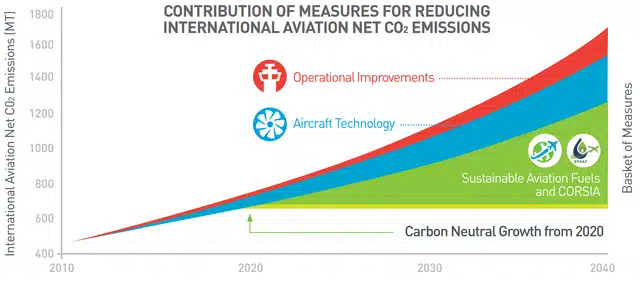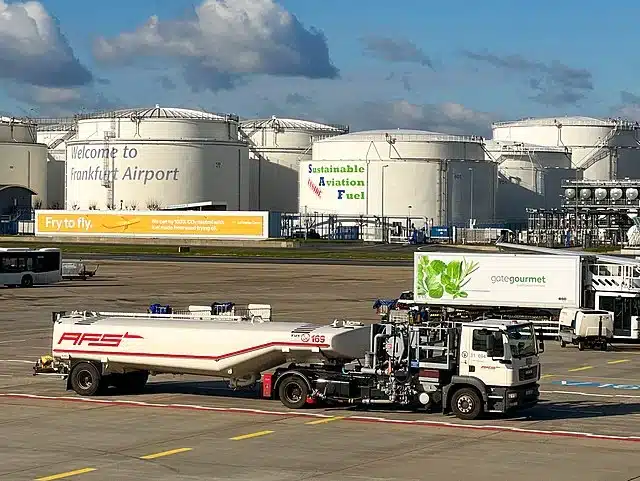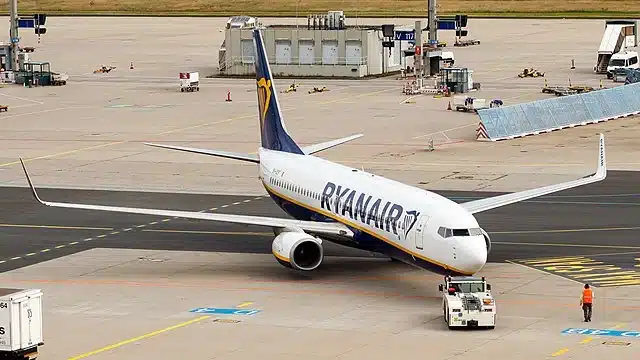Aviation Sustainability and Transformation Plans
The Pillars of Sustainability and Transformation Plans
In the coming years, required financial reporting must include additional climate-related information in addition to ESG reporting. A market-driven project called the Task Force on Climate-Related Financial Disclosures (TCFD) aims to provide guidelines for Sustainability and Transformation Plans. Voluntary and uniform disclosure of climate-related financial risk in aviation business filings. Access to capital and its costs are anticipated to be related more and more to the degree of climate risk and the development of sustainability.
Climate Crisis Climate Solution
The challenges of climate change in aviation is not just limited to tail-pipe emissions and the need to reduce them, every company faces hurdles due to sustainability such as emissions offsets, credits and reporting. Airlines have all of these AND the effects of climate change, such as extreme weather and everything else mother nature can throw at us. These effects are felt by every stakeholder down to the passenger.
While technology has been developed in recent years – and AI promises so much more – aircraft operations can be affected greatly, costing billions and damaging commercial, tourism activities and the circular economy. As we will see in later parts of this article, the aviation industry is difficult to decarbonize. As a result, it is coming under more and more pressure from regulators, governments and investors to come clean.

The TCFD has widespread support, with about 60% of the top 100 publicly traded corporations in the world endorsing it. By implementing TCFD disclosures for aviation organizations starting in April 2023, we are setting the standard. By virtue of the Corporate Sustainability Reporting Directive, the majority of lessors and banks will also be required to report on ESG starting in 2023.
Adaptation to climate change will require efforts from each and every stakeholder to guarantee worldwide sustainability. Not just the airlines – I am talking about the breadth of climate related collaborators who can and will make climate change impacts; such people as
- Regulators
- Government Bodies
- Scientific Communities
- Industrial Communities
Finance
How, I hear you ask?. Money. We need new disruptive technologies and delivery schedules for these technologies, and we need every stakeholder to pay and play their part. Sustainable Aviation Fuel, new battery technology, better Air Traffic Control policies and useable Hydrogen propulsion are all needed. But they need to cost the airline the same as Jet fuel.
The Tale of Four
You will notice a commonality in this article. The Number 4. Every Organization, Airline and Association likes to use FOUR PILLARS to describe both the challenges and the Solutions. So if you are preparing a sustainability and transformation plan for your organization – you better have at least four.
Here they are
Technology
Airlines have aircraft and engines. Airports have ground vehicles and power requirements, ATC has power needs. All have technology needs.
Sustainable Aviation Fuels
Yes this is down to the Airline operators, but SAF is an industry that needs investment and infrastructure. Especially at Airports. Maybe you can be part of that solution. And don’t forget Hydrogen and Battery technology. Who is going to pay to bring these energy sources to market?
Market Based Measures (MBMs)
In the EU we have ETS and around the world we have Corsia. Credits are getting a bad rep and for good reason, but we must start somewhere. Make sure your MBM’s are accredited and recommended. More on this below.
Improved Infrastructure and Operations
We can all improve our operational efficiency. Some groups can do better than others and deliver more gains (especially in air traffic management). But aircraft operations are also a deep well of possibilities. Thankfully we now have large academic and professional groups look at ways to fly airplanes.
If you look at your goals and plans through these 4 lenses then you won’t go to far wrong. You may not be operating aircraft but you certainly can improve your footprint and actively pursue MBM’s such as carbon credits
What is Sustainability & Transformation Planning?
Let’s think about that for a moment. We need (and have) new propulsion systems, battery, hybrid and hydrogen. We have new geared architecture for jet engines and a glut of other solutions coming down the runway. The question is… who is going to develop and run these programs? Who is going to operate these aircraft and ground handle them? We know the answer because these programs are already in place.
But what about sustainability plans?
Who is going to create the climate adaptation training content? Who is going to manage the culture of sustainability in every organization? What do you want the outcomes to be? And how are you going to communicate that to your employees?
Who are the STP leaders?
Who has the most important job of all? Educating the up and coming students and trainees on how they can help us and how badly we need them. Who will take the reins of the Sustainability programs? Who will make future generations and the greater population the priority in the fight to reduce the STP footprint. It’s going to the
Strategy and Targets
Key Role : Chief Sustainability Officer (reporting to the CEO and the Board)
Objective : Meet at least Quarterly to review the Company/Group sustainability program against priorities and goals as well as people-plans
Key KPIs :
Carbon Transition Pathways
Carbon Disclosures / Reporting
Investment in Emissions Technologies / Innovation
Communication with Staff and Customers
What do Sustainability and Transformation Plans mean for Aviation?
Sustainability and Transformation plans (STPs) represent a new way of thinking for aviation executives. These initiatives focus on reducing emissions, improving efficiency, and promoting sustainability in their company. The goals of an STP Manager are to create robust plans for reducing emissions and improving operational efficiency. While also ensuring that their energy needs are compliant with global environmental regulations. Additionally, an STP seeks to promote sustainable initiatives related to safety, security, infrastructure, operations, customer service, training, and workforce development.

The Importance of Sustainability in Aviation
With the increased focus on sustainability and reducing emissions in the aviation industry, it is important for companies to understand the importance of this to their employees and customers. By implementing a comprehensive sustainability and transformation plan (STP), you can reduce your environmental impact, but also create a better company. You need to report factually and avoid Greenwashing or misleading customers or employees on what exactly is being done. Young people especially are fully aware of what is happening to the planet.
“Delta is looking to the future of sustainable aviation while addressing the current impact of our carbon emissions. It is why we committed to carbon neutrality in March of 2020 and why we have also committed to setting a science-based targets to align with the Paris Agreement,” – Ed Bastian, CEO Delta Air Lines
The Sustainability strategy of Airlines - United & Ryanair
We know what keeps Airline Chief Executive’s up at night. Yes, there’s the load factor and yield reports but its also their confidence in transformation plans for the future. Without sustainability, they have no future. CEO’s and the Airline boards need transformation plans and investments to match. Let’s look at what two TOP airlines are doing. So we can learn some lessons.
United Airlines
One of the world’s MAJOR players in aviation. One of the longest serving legacy carriers in the World, United Airlines.
Their Strategy is (you guessed it) four-fold;
- REDUCTION : Their number one commitment is reducing their environmental impact by maximizing operational and fuel efficiency as well decreasing reliance on conventional jet fuel, by adopting SAF.
INNOVATION : United are committed to innovating Carbon Reduction Technologies. The primary approach they employ is to decrease their environmental impact is through sustainable aviation fuel (“SAF”).
CARBON REMOVAL : They say they will employ efforts that go beyond current methods of emission reduction by prioritizing carbon removal. This can be done through technologies that involve carbon sequestration or the potential use of captured carbon to produce low-carbon or even carbon-negative fuels in the future.
ENGAGEMENT : Through collaboration with aviation and non-aviation stakeholders United will work with employees, customers, airports, suppliers, cross-industry partners, policymakers, and others to promote the future of sustainable flight.
Ryanair's Sustainable Target
Thankfully, Ryanair’s sustainability efforts are as clean and clear as their baggage charging policies. They go next-level with their fact-based strategies. A lot of their success does depend on other stakeholders however, (especially Air Traffic Management providers). But their tool box is certainly full of potential. And guess how many pillars they have? You guessed it…
1. Flight Planning Systems – A dynamic and new data-driven flight planning system that can deliver much better fuel planning scenarios as well as financial savings.
2. EMS or Environment Management System – Using a Company called ETS AERO, Ryanair monitors and calculates its greenhouse gas emissions. This company accreditation is ISO 14065 and ISO 14064 (in case you are researching providers).
3. Ground Handling – By Using Electrically powered GPUs (Ground power Units) and other electrically powered ground handling equipment and vehicles, especially in Spain and in the Scandinavian countries.
4. Flight Operations – A number of practical improvements in the daily operations of aircraft can deliver savings. Most notably;
- Continuous Descent Operation
- Single-Engine Taxi
- Point to Point Flying

Airline Sustainability Report Practice - Example Documents
The good news for you is that the Airlines and Lessors must report their corporate sustainability.
Here’s a few notables. This allows you to see how and what they are doing, regardless of the economy. They also must report their access to transformation funding.
Sustainability and Transformation - Organizations to Follow
There are many. But within Aviation we really only want to promote two. IMPACT is a new organization that represents the financial community such as banks and investors. This vital source of funding for commercial aircraft have come together under IMPACT to make sure their voices are heard and that they are getting the correct information from industry.
Aviation Benefits Beyond Borders is an initiative from the Air Transport Action Group .
Anything and everything regarding sustainability reporting, proposals on solutions, Sustainability and transformation plans can be found here. Our suggestion is that each individual organization become a member or subscribe to either or both of these groups.
Statutory Bodies - Sustainability
Each country will have national bodies or Aviation Authority authority involvement in Sustainability. Here is the FAA Sustainability Resource. Here is EASA Sustainability Recourses. You can also find them at the CAAC and the Indian Aviation Authority .
These authority organizations and their broader partners provide the planning guidance and process that your team teams need. Some, such as the Federal Aviation Administration provide a digital roadmap for partner organizations so they can create their Sustainability and Transformation Plan. These principal agencies are the managers of rules set by IATA and ICAO in how we are going to reach Net Zero 2050. Agency activity, agency functions and agency goals are what will make the difference. There is laws and regulations incoming and it is how these laws are delivered that will make real change. If they care, so will we.
Government Accountability in Aviation Sustainability
The aviation industry is being held to a higher standard of sustainability and transformation by governments around the world. As more countries adopt climate-focused policies, the need for airlines, aviation authorities and other aviation stakeholders to comply with these new regulations is becoming increasingly important.
Social responsibility discussions amongst government senior leaders will result in laws. One key way for stakeholders to stay on top of government accountability in aviation sustainability and transformation is to become familiar with statutory bodies that have been established in many countries. These bodies are responsible for developing and enforcing regulations related to sustainability and transformation, such as reducing greenhouse gas emissions or improving safety standards.
Sustainability and Transformation Plans
Additionally, lists of leaders can provide guidance to regulatory agencies on how to develop effective sustainability and transformation plans. It’s also important for stakeholders to stay informed about any recent developments from relevant agencies that could affect their operations or future plans. By staying up-to-date on training pathways from these organizations, stakeholders can ensure they are compliant with all relevant regulations and make sure their Sustainability and Transformation Plan is successful.
Sustainability Training Resources - Top Choices
Design a Sustainability Strategy
Aviation and the Environment
Carbon Markets and Aviation
Sustainability and Communications Strategies
Environmental management Systems
Sustainability and Transformation Roles
There are a myriad of roles in Sustainability and Transformation planning. We wanted to give you a selection from OEMs, Airlines and Suppliers. OEMs are responsible for designing and building aircraft. Sustainability is deeply integrated into their operations. All other roles try to operate these vehicles as best as we can.
Sustainable Aircraft Design Engineers
These engineers focus on creating aircraft with reduced carbon emissions, noise pollution, and improved fuel efficiency. They work on aerodynamics, materials, and propulsion systems to achieve these goals.
Environmental Compliance Specialists
These experts ensure that OEMs meet strict environmental regulations and certifications. They work to minimize the environmental impact of aircraft production.
Sustainability Analysts
Sustainability analysts assess the life cycle of aircraft, identifying opportunities for improvement in efficiency, recyclability, and sustainability practices.
Airlines - Sustainability and Transformation Planners
Fleet Operations Managers
These managers oversee fuel-efficient flight planning, maintenance schedules, and fleet optimization to reduce carbon emissions and operational costs.
Sustainability Communication Specialists
Airlines hire professionals to convey their sustainability efforts to the public. They create marketing campaigns and engage with passengers to promote eco-friendly practices.
Airport Sustainability Managers
These managers focus on reducing an airport’s environmental footprint by implementing energy-efficient infrastructure, waste management programs, and renewable energy sources.
Green Terminal Designers
Architects and designers specialize in creating environmentally friendly terminal buildings that utilize natural light, efficient HVAC systems, and sustainable materials.
Sustainable Materials Suppliers
Suppliers of lightweight and eco-friendly materials, such as composites and biofuels, contribute to reducing the environmental impact of aircraft manufacturing.
Eco-certification Consultants
Experts help suppliers obtain eco-certifications, ensuring their products meet the sustainability standards demanded by OEMs and airlines.





